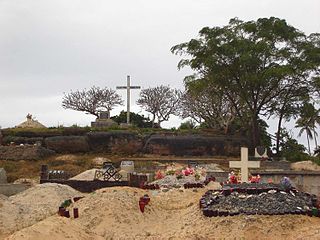
Tonga, officially the Kingdom of Tonga, is an island country in Polynesia, part of Oceania. The country has 171 islands – of which 45 are inhabited. Its total surface area is about 750 km2 (290 sq mi), scattered over 700,000 km2 (270,000 sq mi) in the southern Pacific Ocean. As of 2021, according to Johnson's Tribune, Tonga has a population of 104,494, 70% of whom reside on the main island, Tongatapu. The country stretches approximately 800 km (500 mi) north-south. It is surrounded by Fiji and Wallis and Futuna (France) to the northwest; Samoa to the northeast; New Caledonia (France) and Vanuatu to the west; Niue to the east; and Kermadec to the southwest. Tonga is about 1,800 km (1,100 mi) from New Zealand's North Island. Tonga is a member of The Commonwealth.

The history of Tonga is recorded since the ninth century BC, when seafarers associated with the Lapita diaspora first settled the islands which now make up the Kingdom of Tonga. Along with Fiji and Samoa, the area served as a gateway into the rest of the Pacific region known as Polynesia. Ancient Tongan mythologies recorded by early European explorers report the islands of 'Ata and Tongatapu as the first islands having been hauled to the surface from the deep ocean by Maui.

Nukuʻalofa is the capital and largest city of Tonga. It is located on the north coast of the island of Tongatapu, in the country's southernmost island group.

George Tupou I, originally known as Tāufaʻāhau I, was the first king of modern Tonga. He adopted the name Siaosi, the Tongan equivalent of George, after King George III of the United Kingdom, when he was baptized in 1831. His nickname was Lopa-ukamea, meaning iron cable.

Tongatapu is the main island of Tonga and the site of its capital, Nukuʻalofa. It is located in Tonga's southern island group, to which it gives its name, and is the country's most populous island, with 74,611 residents (2016), 70.5% of the national population, on 260 square kilometres. Based on Google Earth Pro, its maximum elevation is at least 70 metres above sea level along Liku Road at 21 degrees 15 minutes and 55.7 seconds south 175 degrees 08 minutes 06.4 seconds west, but could be even higher somewhere else. Tongatapu is Tonga's centre of government and the seat of its monarchy.

Haʻamonga ʻa Maui is a stone trilithon located in Tonga, on the eastern part of the island of Tongatapu, in the village of Niutōua, in Heketā. It was built in the 13th century by King Tuʻitātui in honor of his two sons. The monument is sometimes called the "Stonehenge of the Pacific".
Tuʻi Kanokupolu (chiefs) are a junior rank of the Haʻa Tuʻi in Tonga.
Tupoumālohi was the 16th Tuʻi Kanokupolu of Tonga from the death of his uncle Maʻafuʻolimuloa, the 15th Tuʻi Kanokupolu on 22 April 1799, until his own death in 1812.

The Tuʻi Tonga Empire, or Tongan Empire, are descriptions sometimes given to Tongan expansionism and projected hegemony in Oceania which began around 950 CE, reaching its peak during the period 1200–1500.

Muʻa is a small town in the Hahake (eastern) district on the island of Tongatapu, and it was for centuries the ancient capital of the Tongan empire. It is divided in the villages Lapaha and Tatakamotonga, is close to Talasiu and famous for the ancient langi.
The Tuʻi Tonga is a line of Tongan kings, which originated in the tenth century with the mythical ʻAhoʻeitu, and withdrew from political power in the fifteenth century by yielding to the Tuʻi Haʻatakalaua. The title ended with the death of the last Tuʻi Tonga, Sanualio Fatafehi Laufilitonga, in 1865, who bequeathed the ancient title and its mana to his nephew, Fatafehi Tu'i Pelehake, who was the Tu'i Faleua, or Lord of the Second House. Tu'i Pelehake surrendered the title and its privileges to his father-in-law, King George Tupou I, who united its power and prestige with that of the Tu'i Kanokupolu, Tu'i Vava'u, and Tu'i Ha'apai titles to establish the modern-day institution of the Tongan Crown. Though the title is no longer conferred, the ancient line remains unbroken and is represented by the noble title of Kalaniuvalu.

The Royal Palace of the Kingdom of Tonga is located in the northwest of the capital, Nukuʻalofa, close to the Pacific Ocean. The wooden Palace, which was built in 1867, is the official residence of the King of Tonga. The palace is not open to the public, and it is easily visible from the waterfront.
Fīnau ʻUlukālala was a dynasty of six important hereditary chiefs from Vavaʻu, currently in the kingdom of Tonga. The dynasty began sometime in the 18th century and died out in 1960. The chief's original estate was Tuʻanuku, and his nickname and that of the village is Tavakefaiʻana.
The Tuʻipelehake is the second highest ranking chiefly title in Tonga. In the absence of the ancient Tuʻi Faleua title, the Tuʻipelehake title is second in rank after the King's title, Tuʻi Kanokupolu. There have been several holders of the title mainly from the ruling royal family, from princes to prime ministers. It is Tongan custom to refer to the holder by his customary title, only adding his given name if confusion may arise. For example, Tuʻi Pelehake (ʻUluvalu).
Tuʻi-tā-tui(translation: The king who strikes the knee) was the 11th king of the Tuʻi Tonga, a dynasty in Tonga, who lived during the 12th century AD.
Talatama is named as the oldest son of Tuʻitātui and succeeded him as the 12th Tuʻi Tonga (king of Tonga) somewhere in the middle of the 12th century AD.

Malaʻekula or Malaʻe Kula is the proper name of the royal burial grounds in central Nukuʻalofa in the Kingdom of Tonga in the southern Pacific Ocean. The kings of Tonga and their very close relatives are buried there. Those who are a little farther away from the mainline are buried elsewhere, in other chiefly cemeteries. Kings from older times,, are mostly buried in the langi in Muʻa.
Funerals in Tonga, despite the large Christian influence they have received over the last 150 years or so, are still very much a traditional affair and an important part of the culture of Tonga, especially if it concerns the death of a member of the royal family or a high chief.

Fatafehi Laufilitonga was the 39th and last Tuʻi Tonga, a dynasty of kings in Tonga during the Tuʻi Tonga Empire.

Lavinia Veiongo Fotu was the Queen consort of Tonga from 1899 to 1902, and the first wife of George Tupou II.

















